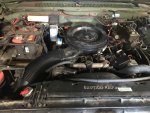- 359
- 272
- 63
- Location
- Amersfoort, The Netherlands
I'd keep that engine in a cleanroom!With all that $$ invested, I’m surprised you don’t have the manifold intake covered to prevent any FOD from getting inside.
Steel Soldiers now has a few new forums, read more about it at: New Munitions Forums!

I'd keep that engine in a cleanroom!With all that $$ invested, I’m surprised you don’t have the manifold intake covered to prevent any FOD from getting inside.
The manifold is not bolted down yet. The GEP tape is still covering the openings in the heads. I still need to connect the flexible fuel line from the FFM to the IP and make one last adjustment to the TV cable, and then I’ll be ready to remove the factory tape and bolt her down. At that time I will tape over the breather hole to prevent anything from falling in there. Good catch by the way.With all that $$ invested, I’m surprised you don’t have the manifold intake covered to prevent any FOD from getting inside.
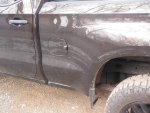
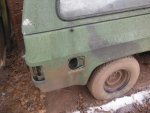
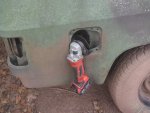
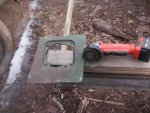
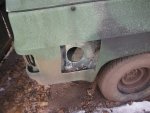 After the phone call I went out and cut the fuel door opening out of the 1/4 panel. This M1009 will never be back on the road. It had 13 K miles and I bought it as residue. That cordless Milwaukee is an awesome tool. I was sure you want the CUCV one. The Z71 was a different size. You need the M1008 filler neck , hoses and fuel cup. The cap may be the only thing I don't have extra. But I do somewhere. I know you like new. Can you find a new cap with nice lettering?
After the phone call I went out and cut the fuel door opening out of the 1/4 panel. This M1009 will never be back on the road. It had 13 K miles and I bought it as residue. That cordless Milwaukee is an awesome tool. I was sure you want the CUCV one. The Z71 was a different size. You need the M1008 filler neck , hoses and fuel cup. The cap may be the only thing I don't have extra. But I do somewhere. I know you like new. Can you find a new cap with nice lettering?Rick - thanks for getting the fuel door assembly for me. It will be the finishing touch for the factory auxiliary tank install. Yes I think I know where a NOS fuel cap is. Now all I need to decide is a source for the auxiliary tank. Do you have any experience with those LMC tanks? Or would you rather look for a clean used one? Or do you know another source for a new tank? Any help you can provide will be appreciated. MikeView attachment 754449View attachment 754450View attachment 754451View attachment 754452View attachment 754453After the phone call I went out and cut the fuel door opening out of the 1/4 panel. This M1009 will never be back on the road. It had 13 K miles and I bought it as residue. That cordless Milwaukee is an awesome tool. I was sure you want the CUCV one. The Z71 was a different size. You need the M1008 filler neck , hoses and fuel cup. The cap may be the only thing I don't have extra. But I do somewhere. I know you like new. Can you find a new cap with nice lettering?
Yes I am interested. PM me with a price and we will try to make it happen.I have an original tank with the original mounts, sending unit and all. No Skid Plate. Interested? I can take a few pictures.
Yes just a little. I've been extremely busy the past few months helping manage my wife's company, but have almost completed the mock-up of the custom aluminum bracket to hold the Spinner oil filter. I had to draw the bracket to scale and then custom bend 3/16" 6061 aluminum to fit. I used a 3/4" x 1" 6061 solid aluminum bar to fabricate the bottom mount, which itself mounts into two of the valve cover bolt holes. The Spinner will receive its oil pressure from the front turbo port (which will not be used because I am not going to turbo the engine). I plumbed the turbo port with rigid brass piping to a stainless aircraft on-off valve just above the crossover. From that valve to the Spinner I will fabricate -4AN flexible hose which will snake around the air cleaner. When in operation at 35psi, the Spinner will spin inside the vessel at approximately 6000 rpm and remove all impurities from the oil via inertia. All impurities in size down to sub-micron will be forced to the inner wall of the spinning vessel, where they will accumulate. The cleaned oil will then drain down into the valve cover via gravity. During normal maintenance the outer vessel of the Spinner can be quickly removed and scraped out and cleaned. For those readers who do not know, a germ's body is 1 micron wide. A normal factory oil filter will remove particles and contaminents in size down to approximately 20 micron. The engine gaps between bearing surfaces range in size from 5-10 micron, which means the factory oil filter allows particles and impurities smaller than 20 micron to pass through to the bearing surfaces. As the factory oil filter traps impurities and contaminents and becomes less efficient, the micron size increases. The Spinner will remove these smaller contaminents, and even remove the carbon blow-by to keep the oil honey-colored. Once I get the engine installed and all systems in operation, I plan to take regular oil samples at 1000-mile intervals to monitor the efficiency of the Spinner. It should be interesting. Here are a few photos -Any new progress Mike?
Yes just a little. I've been extremely busy the past few months helping manage my wife's company, but have almost completed the mock-up of the custom aluminum bracket to hold the Spinner oil filter. I had to draw the bracket to scale and then custom bend 3/16" 6061 aluminum to fit. I used a 3/4" x 1" 6061 solid aluminum bar to fabricate the bottom mount, which itself mounts into two of the valve cover bolt holes. The Spinner will receive its oil pressure from the front turbo port (which will not be used because I am not going to turbo the engine). I plumbed the turbo port with rigid brass piping to a stainless aircraft on-off valve just above the crossover. From that valve to the Spinner I will fabricate -4AN flexible hose which will snake around the air cleaner. When in operation at 35psi, the Spinner will spin inside the vessel at approximately 6000 rpm and remove all impurities from the oil via inertia. All impurities in size down to sub-micron will be forced to the inner wall of the spinning vessel, where they will accumulate. The cleaned oil will then drain down into the valve cover via gravity. During normal maintenance the outer vessel of the Spinner can be quickly removed and scraped out and cleaned. For those readers who do not know, a germ's body is 1 micron wide. A normal factory oil filter will remove particles and contaminents in size down to approximately 20 micron. The engine gaps between bearing surfaces range in size from 5-10 micron, which means the factory oil filter allows particles and impurities smaller than 20 micron to pass through to the bearing surfaces. As the factory oil filter traps impurities and contaminents and becomes less efficient, the micron size increases. The Spinner will remove these smaller contaminents, and even remove the carbon blow-by to keep the oil honey-colored. Once I get the engine installed and all systems in operation, I plan to take regular oil samples at 1000-mile intervals to monitor the efficiency of the Spinner. It should be interesting. Here are a few photos -
Free from all the stuff determined by the state of cancer to cause CaliforniaNow, this is my kinda guy.. I'm sorry for offending any purists. But this is the only vehicle in the people's republic of California, that can be a clean slate. No gov laws, no smog, low reg fees.
Well after several months hiatus helping manage my wife's company, I am finally ready to get back to work on my P400 / 700R4 build and continue this rebuild thread, which has now gone on for nine (9) years.Any new progress Mike?
The TV cable bracket for a 6.2 diesel engine is rare, however can be obtained through Ebay occasionally. Sometimes a fellow Steel Soldier member will have one for sale. I purchased mine by watching Ebay on a daily basis. If I remember correctly, I paid $100 for mine. The TV cable is still available on Ebay as well. It is GM part #25515599, 36.1 overall length, cable code FK.I've read through the whole thread and I seem to be missing one thing. Where did you get the TV cable and corresponding brackets for the diesel? Also just wondering why you didn't go turbo with the bigger motor? Thank you in advance for your reply and your work is great and inspiring to me.
